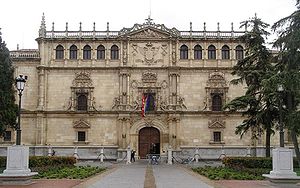
Purism is an initial phase of Renaissance architecture in Spain, which took place between 1530 and 1560, after Isabelline Gothic and prior to the Herrerian architecture in the last third of the 16th century. The name "Prince Philip" refers to the period in which Philip II of Spain (born in 1527) had not yet received the inheritance of the Spanish Monarchy by abdication of his father, the Emperor Charles V (1556). The name "Serlian" is due to the influential architect and treatise Sebastiano Serlio (in addition to the architectural element called Serlian in his honor).
The Greco-Roman, the purist and the casticist are related to the interpretation given to different elements of style, whether intellectual, formal, structural or decorative. Until then, writers of the period termed the classicist forms of the Italian Renaissance as "the Roman" (Diego de Sagredo Las Medidas del Romano, 1526), while the late-Gothic forms were called "the modern".[1] For a more stylistic periodization more common in the art history, at that point of the 16th century the Cinquecento had entered in its Mannerist phase, while for the Spanish art is commonly used the expression High Renaissance (reserving the term Low Renaissance for the last third of the century).
- ^ Maroto, J. Historia del Arte, Casals, ISBN 978-84-218-4021-4, pg. 195